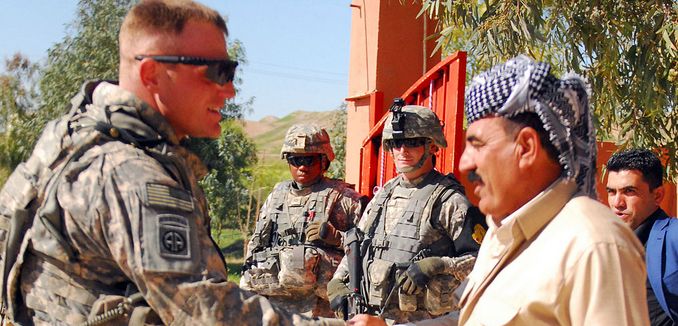Amid recent Kurdish battle victories against the Islamic State of Iraq and Syria (ISIS) and promised American military aid, the Kurdish dream of an independent state may soon be getting at least tacit American support, according to a report Monday by Eli Lake of Bloomberg News.
These battlefield victories underline an equally striking change in U.S. policy: Starting in 2015, the U.S. military will be training three brigades of peshmerga and spending more than $350 million equipping them for battle with the fanatics tearing Iraq apart. While the Kurds have been semi-independent since 1991, with their own government, militias and foreign policy, this is the biggest step yet toward Washington allowing them to have a state of their own.
Despite the measures of independence Iraqi Kurds have gained in recent years, Lake observes that “The one thing the Kurds do not have, however, is a modern army.” However Lake writes that American support may change that.
On a visit to Washington last month, Fuad Hussein, [Kurdistan Regional President Massoud] Barzani’s chief of staff, told reporters that his government was now beginning the process of creating a centralized Kurdish army. And this is where U.S. training of three Kurdish brigades could make a major difference. If the peshmerga transforms from a localized guerilla militia into a modern army, then one of the remaining pieces necessary for Kurdish independence will fall into place.
Even with this help, the idea of Kurdish independence will not likely be embraced openly by many in Washington, who prefer to advocate for Kurdish military cooperation with the central government in Iraq, as part of a “one Iraq” policy. But as Lake points out, the Kurdish peshmerga fighters won’t want to “be commanded by officers from the Iraqi Army,” especially after many of those officers fled from advancing ISIS forces rather than fighting them.
Earlier this week, the peshmerga retook the northern section of the Iraqi city of Sinjar from ISIS following American-led bombing of the area, freeing hundreds of Yazidi who were trapped on Mount Sinjar.
In Say it Again, Kurdish Independence Now, which was published in the September 2013 issue of The Tower Magazine, Jonathan Spyer offered a brief survey of the three major Kurdish regions in the Middle East.
After the First Gulf War in 1991, a Kurdish autonomous zone was created in northern Iraq. Since the 2003 US invasion, this zone has emerged as a quasi-sovereign entity, with its own armed forces, political system, and economic interests. Traveling there today is to witness a little-known Mideast success story in the midst of regional chaos and meltdown. The autonomous zone is the most peaceful part of Iraq, and the absence of political violence is encouraging investment. Erbil, the capital city, feels like a boom town. There are construction cranes everywhere and brand new SUVs on the streets. Exxon Mobil has signed an agreement with the KRG to search for oil and develop an energy industry in the zone. The US, France, and a number of other countries now have consulates in the capital.
But Kurdish politics don’t start and finish in northern Iraq. The second major nationalist movement began with a 1984 uprising led by the Partiya Karkerên Kurdistan (the Kurdish Workers Party or PKK) in southeast Turkey, with the goal of founding a Kurdish state. The rebellion and the Turkish response to it went on to claim more than 40,000 lives. But this year, a ceasefire was declared and a peace process begun in hopes of ending the conflict.
Meanwhile, the Syrian civil war has led to the emergence of a Kurdish-ruled enclave in the northeast of the country. This area is controlled by the Kurdish Democratic Party (PYD), an offshoot of the PKK. This embryonic autonomous zone is poorer and more fragile than its Iraqi counterpart. But it too is the quietest and most peaceful part of that war-torn country. PYD-imposed authority is ubiquitous. The Yekîneyên Parastina Gel (People’s Protection Units or YPG) militia does as much as possible to prevent the entry of both Islamist rebels and Assad regime soldiers. The militia and the Kurdish security service, the Asayish, maintain an extensive presence and a firm grip on the area.
Spyer observes:
It is very telling that the Kurdish areas in both Syria and Iraq have become destinations for Arab refugees from elsewhere in these countries. There is a simple reason for this: Generally speaking, where the Kurds are in control, things stay quiet.
[Photo: U. S. Army Photo / Flickr ]




